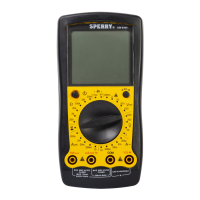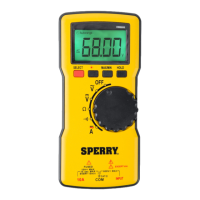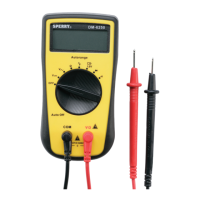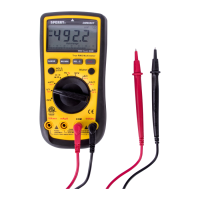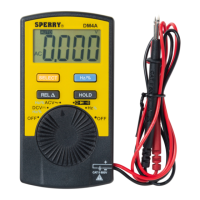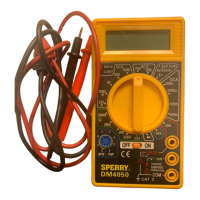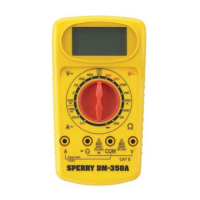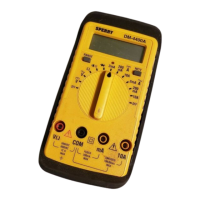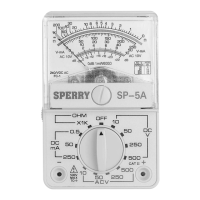RANGE RESOLUTION ACCURACY
200.0Ω 0.1Ω
±(0.8%+3)
2.000KΩ 1Ω
20.00kΩ 10Ω
200.0kΩ 100Ω
2.000MΩ 1kΩ
±(1.2%+5)
RESISTANCE
3
Incoming wire
Interior wiring
CAT. III
Transformer
CAT. II
CAT. I
CAT. IV
Socket
Symbols
Caution, risk of danger, refer to the operating manual before use
Caution, risk of electric shock
AC (Alternating Current)
DC (Direct current)
AC/DC Selectable (Alternating Current/Direct Current)
Earth (ground) Terminal
The equipment is protected throughout by
double insulation or reinforced insulation
Application around and removal from hazardous
live conductors is permitted.
Conforms to Standards of European Union
Designates the product as recyclable
electronic waste per WEEE Directive
Measurement categories (Over-voltage categories)
To ensure safe operation of measuring instruments, IEC61010 establishes safety standards for various electrical environments,
specified as CAT I through CAT IV, and called measurement categories. Higher-numbered categories correspond to electrical
environments with greater momentary energy, so a measuring instrument designed for CAT III environments can endure greater
momentary energy than one designed for CAT II.
• CAT I: Secondary electrical circuits connected to an AC electrical outlet through a transformer or similar device.
• CAT II: Primary electrical circuits of equipment connected to an AC electrical outlet by a power cord.
• CAT III: Primary electrical circuits of the equipment connected directly to the distribution panel,
and feeders from the distribution panel to outlets.
• CAT IV: The circuit from the service drop to the service entrance, and to the power meter and
primary over current protection device (distribution panel).
• Avoid placing the meter in areas where vibration, dust or dirt is present. Do not store the meter in excessively hot, humid or damp places.
• This meter is a sensitive measuring device and should be treated with the same regard as other electrical and electronic devices.
• When the meter is not in use keep the meter turned off to keep the battery from discharging.
• When disconnecting the test leads from the unit, always grasp the leads where the input jacks meet the tester housing.
Do not pull the leads out of the jacks by the insulated wire or transport the tester using the test leads as a carrying strap.
3.0 SPECIFICATIONS
3.1 MEASURING RANGE & ACCURACY
RANGE RESOLUTION ACCURACY
200uA 0.1uA
±(1.0% + 3)
20mA 10uA
200mA 100uA
10A 10mA
±(2% + 3)
- Frequency Response: 40Hz - 400Hz
AC CURRENT
RANGE RESOLUTION ACCURACY
200V 100mV
±(0.8% + 5)
600V 1V
±(1.5% + 5)
- Frequency Response: 40Hz - 400Hz
AC VOLTAGE
RANGE RESOLUTION ACCURACY
200uA 0.1uA
±(0.8% + 3)
20mA 10uA
200mA 100uA
10A 10mA
±(1.2% + 5)
DC CURRENT
RANGE RESOLUTION ACCURACY
200.0mV 0.1mV
±(0.7%+5)
2.000V 1mV
±(0.5%+5)
20.00V 10mV
200V 0.1V
600V 1V
±(0.8%+5)
DC VOLTAGE
RANGE RESOLUTION ACCURACY
0.1Ω
≤10Ω Buzzer beep
10Ω-70Ω Buzzer may or may not beep
≥70Ω No buzzer beep
- Open-circuit voltage: about 2V
CONTINUITY TEST
RANGE RESOLUTION
The approximate forward voltage drop of the diode
will be displayed
DIODE
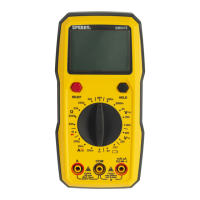
